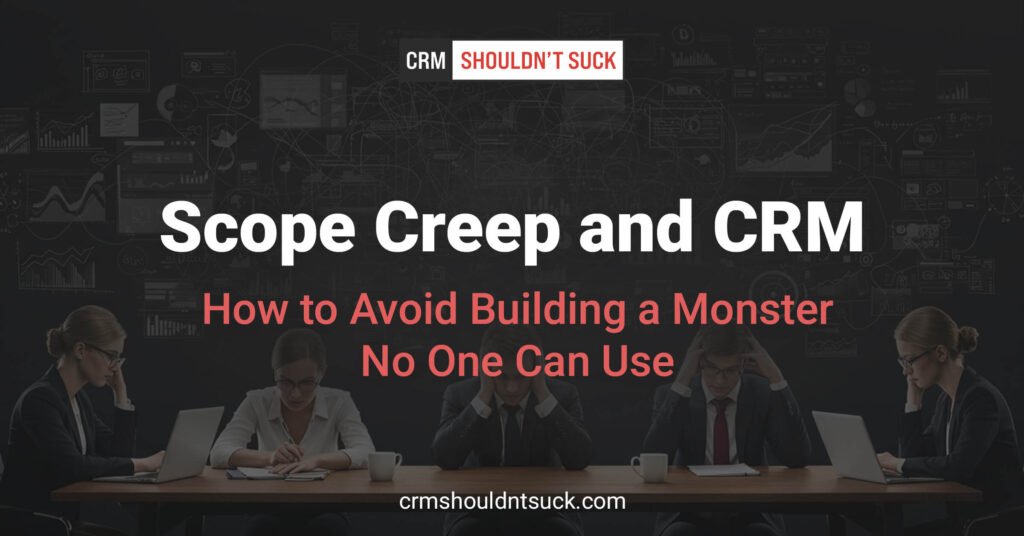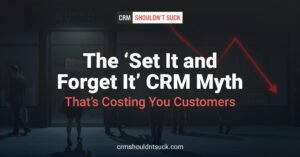The Hidden CRM Killer: Scope Creep
It started with the best of intentions.
Your company needed a new CRM, one that would streamline operations, increase visibility into the pipeline, and improve forecasting accuracy. You gathered the right people, evaluated vendors, and signed the contract for a system that promised to do it all.
Then, the requests started coming in.
“Can we customize this dashboard to track every possible sales metric?”
“What if we add a few extra fields to capture more customer details?”
“Shouldn’t marketing have its own custom workflows, separate from sales and support?”
“We need integrations with all our tools.”
Before you knew it, the CRM had become an unmanageable beast—over-engineered, bloated with unnecessary features, and more of a burden than a solution. Sales reps hated it. Leadership couldn’t get the reports they needed. Adoption rates plummeted.
This is the reality of scope creep, and it is one of the biggest reasons CRM implementations fail.
What is Scope Creep, and Why Does It Happen?
Scope creep occurs when the scope of a project expands beyond its original objectives due to unchecked additions, feature requests, and changing priorities. In CRM implementations, this often happens because companies try to solve every business problem at once, rather than focusing on core needs.
Some common causes include:
- Lack of Clear Objectives: When companies fail to define specific, measurable goals for their CRM, every stakeholder’s wish list becomes a priority.
- Trying to Please Everyone: Departments push for custom features tailored to their specific needs, making the system more complex than necessary.
- Failure to Say No: Without strict governance, requests keep getting added, turning what was supposed to be a straightforward implementation into an unwieldy mess.
- Assumption That More is Better: The belief that more features equal more value, when in reality, more complexity often leads to lower user adoption.
- Poor Change Management: Teams that don’t properly assess how new features impact workflows and training often end up with a system no one understands or wants to use.
The Cost of Scope Creep
Every additional feature or customization in a CRM comes with a cost—both financial and operational. Some of the most damaging effects include:
- Longer Implementation Timelines: The more you add, the more time it takes to configure, test, and deploy.
- Higher Costs: Development, customization, and ongoing maintenance costs can quickly spiral out of control.
- Low User Adoption: The more complicated the CRM, the more likely users are to avoid it or find workarounds.
- Fragmented Data: Overly customized systems often create silos, making it harder to extract meaningful insights.
- Diminished ROI: If your team isn’t using the CRM effectively, it’s just another expensive piece of software.
How to Prevent Scope Creep in Your CRM Implementation
The good news is that scope creep can be controlled. Here’s how to keep your CRM project focused and effective.
1. Define and Document Your Core Objectives
Before you start evaluating CRM vendors or discussing features, establish what success looks like. Identify 3-5 key outcomes your CRM must deliver, such as:
- Increased pipeline visibility
- Improved sales forecasting
- Streamlined lead management
- Enhanced customer retention
These objectives will serve as guardrails, preventing unnecessary additions that dilute the system’s effectiveness.
2. Get Buy-In on a Minimum Viable Product (MVP)
A CRM should launch as a minimum viable product—a system that addresses critical business needs while remaining simple and user-friendly. Additional features can be added later based on actual user feedback and demonstrated needs, rather than hypothetical wish lists.
3. Establish a Governance Team
Create a cross-functional governance team responsible for evaluating all CRM requests. This group should include sales, marketing, customer service, and IT leaders who can assess whether a request aligns with business objectives. If a feature doesn’t add measurable value, it doesn’t get added.
4. Limit Customizations
Customization is one of the biggest drivers of scope creep. While some degree of tailoring is necessary, excessive customization can make the system difficult to update and maintain. Stick to out-of-the-box functionality whenever possible and only customize when it provides a clear competitive advantage.
5. Implement Change Management Early
Training and user adoption should be planned from day one, not as an afterthought. If employees don’t understand how to use the CRM efficiently, they’ll revert to old habits, negating any benefits of the new system.
6. Set Strict Prioritization Criteria
Every request for a new feature or enhancement should be evaluated based on:
- Alignment with business goals – Does it directly support the core objectives?
- Impact on user experience – Will it simplify or complicate workflows?
- Adoption potential – Will it be used by a majority of users, or is it just for a niche group?
- Cost vs. value – Is the cost of development and maintenance justified by the expected ROI?
7. Phase in Enhancements Over Time
A phased rollout ensures that your CRM remains functional and user-friendly while allowing for iterative improvements. Start with the essentials, and introduce new features only when they’ve been validated by real user needs.
The Bottom Line: Keep Your CRM Simple, Effective, and Aligned with Your Business Goals
A CRM should empower your sales team, not overwhelm them. By keeping scope creep in check, you ensure that your system remains usable, scalable, and aligned with your strategic goals.
Before adding anything to your CRM, ask yourself: Does this help us sell more, serve customers better, or improve efficiency? If the answer isn’t a clear yes, it’s probably a distraction.
Choosing the right CRM is only half the battle. Keeping it simple and focused is what will make it a lasting asset for your business, rather than a frustrating burden that your team resents. Stay disciplined, stay focused, and build a CRM that actually works.



